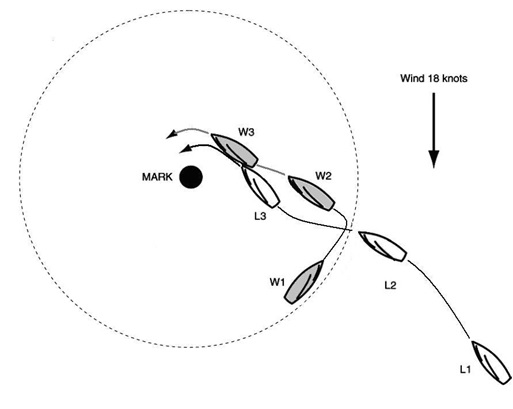



CASE 93
Definitions, Room
Rule 15, Acquiring Right of Way
Rule 16.1, Changing Course
Rule 18.3, Mark-Room: Passing Head to Wind in the Zone
Rule 43.1(b), Exoneration
If a boat luffs immediately after she becomes overlapped to
leeward of another boat and there is no seamanlike action
that would enable the other boat to keep clear, the boat that
luffs breaks rules 15 and 16.1. The other boat breaks rule 11,
but is exonerated.
Facts
At position 1, W and L were on opposite tacks approaching a windward
mark that they were required to leave to port. After W passed head to wind
within the zone and was on her new close-hauled course, L was directly
astern of her. W’s course was far enough above the layline to allow L to
pass between W and the mark. In position 2, L had borne off from a point
close astern of W and was about to overlap W to leeward. When the overlap
began, L immediately luffed and struck W’s port side. The boats then
continued around the mark without further incident. L protested W but L
was disqualified for breaking rule 16.1. She appealed.

Decision
Between positions 1 and 2, while in the zone, W passed head to wind. At
that time, W was fetching the mark, so rule 18.3 began to apply. In her
appeal L argued that W broke rule 18.3. That rule required W to give L
mark-room when L became overlapped inside her. The facts indicate that
W’s course was far enough above the layline to allow L room to sail to the
mark and round it. Therefore, W gave mark-room to L and did not break
rule 18.3.
At position 2, W had right of way over L under rule 12. A short time later,
between positions 2 and 3, the boats became overlapped at which time L
acquired right of way under rule 11, and initially rule 15 required L to give
W room to keep clear. At all times after the boats became overlapped, rule
16.1 applied. L’s luff, which was made immediately after the overlap began,
deprived W of room to keep clear. No seamanlike action was available to
her to do so. L thus broke rules 15 and 16.1.
L was not exonerated by rule 43.1(b) because, at the time she broke rules 15
and 16.1, she was not sailing within the mark-room to which she was
entitled and which W gave her.
When L luffed, W broke rule 11, but she was exonerated by rule 43.1(b)
because she was sailing within the room to which she was entitled under
rules 15 and 16.1.
L became overlapped from clear astern within two of her hull lengths of W,
and so rule 17 prohibited L from sailing above her proper course. The protest
committee did not find facts as to whether or not L sailed above her proper
course after the overlap began. If she did, she broke rule 17. However,
nothing is to be gained by seeking the facts needed to resolve this question
because L would remain disqualified under rules 15 and 16.1.
The protest committee did not discuss rule 14. W did not break rule 14, as
it was not reasonably possible for her to avoid contact. L, however, did break
rule 14; the fact that she caused the contact showed that it was possible for
her to avoid it. She would have been penalized for this breach if there had
been damage or injury to either boat. No facts were found about damage or
injury, but this issue need not be addressed since L would remain
disqualified under rules 15 and 16.1.
For the above reasons L’s appeal is denied.
USA 1998/76






